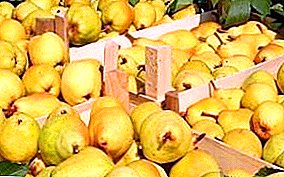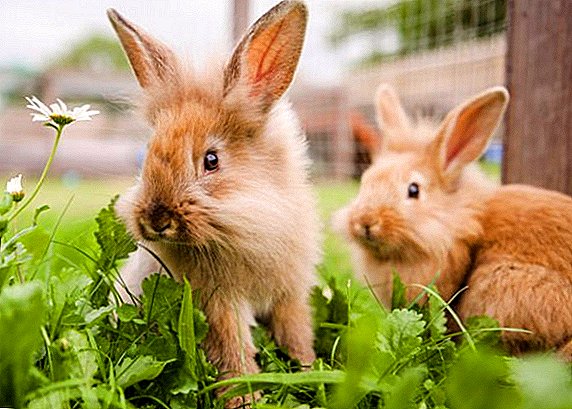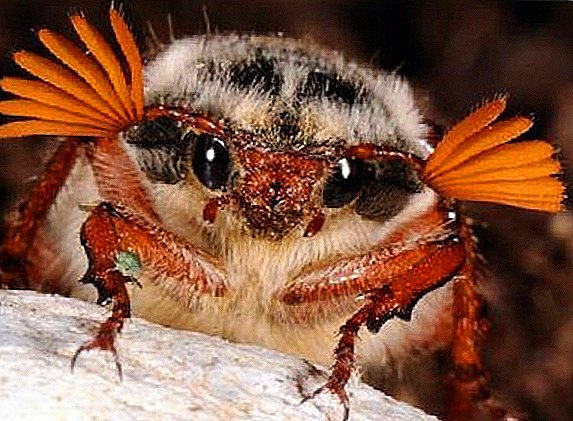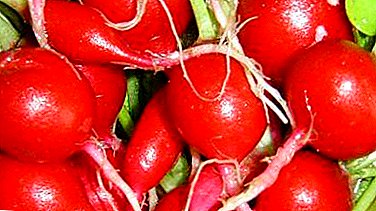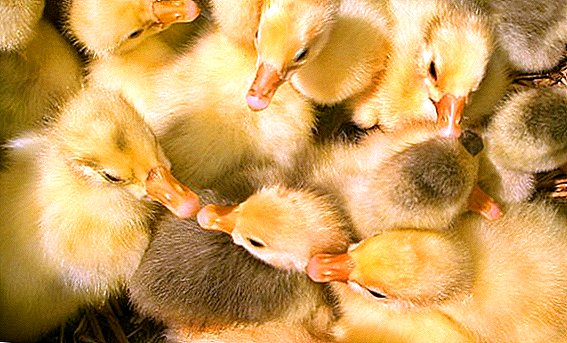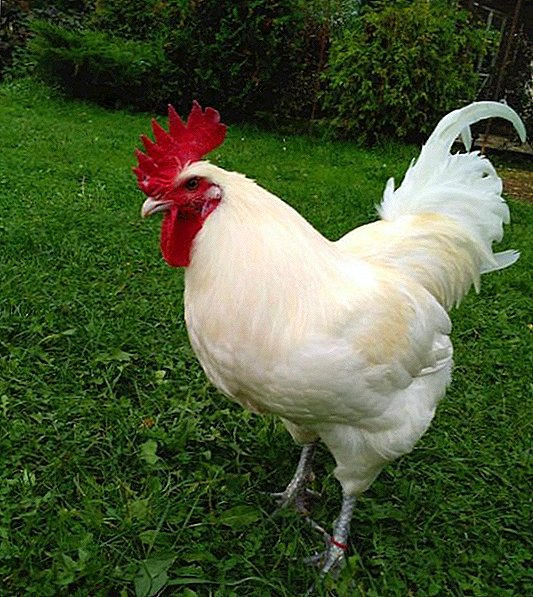 Recently in agriculture and larger poultry farming mini-chickens are gaining more and more popularity. These highly productive chickens are easy to maintain and meet the basic requirements of farmers. The B-66 breed is one of the breeds of mini-chickens, the features of which we consider in our article.
Recently in agriculture and larger poultry farming mini-chickens are gaining more and more popularity. These highly productive chickens are easy to maintain and meet the basic requirements of farmers. The B-66 breed is one of the breeds of mini-chickens, the features of which we consider in our article.
Breed history
Together with other popular breeds of mini-chickens, which are now widely distributed in Europe, B-66 was bred at the All-Russian Research Veterinary Institute of Poultry. There are three main colors of the representatives of this breed: fawn, white and red-black.
Did you know? Contrary to popular belief about the underdevelopment of the chicken brain, the chicken, who is only one day old, demonstrates the same skills and reflexes as a three-year-old child. Moreover, despite the simple structure of the chicken's brain, these birds are able to distinguish the host from other people, memorize about a hundred faces, easily learn new skills and are well oriented in time, knowing well when the time of the next feed will come.All of them are carriers of the dwarfism gene, isolated by selection and careful selection of such breeds as Plymouth, Leggorn, Cornish and Rhode Island. The purpose of creating such chickens was to solve the economic problems in agriculture.

Description and Features
In countries such as the United Kingdom and France, mini-chickens have already completely replaced broilers, not only because of their external distinguishing features, but also because of their calm nature and well-developed maternal instinct.
We recommend you to get acquainted with such meat breeds of chickens as brahma, mekhelenskaya cuckoo, la flush, langshan, Jersey giant, dorking, Kochinquin, orpington and fireball.
External features
The torso of such chickens, despite their compactness, is rather dense and fleshy, with thick plumage, broad back and rounded chest. On the head of a standard size there is a small, leaf-shaped comb, small ears.
Video: B-66 chicken breed description Paws - short, with a shortened metatarsus (it is 30% smaller than other meat breeds). The neck is rather wide. The wings are not well developed, fit snugly to the body.
Temperament
As for the behavior of such chickens, they, unlike other breeds of meat poultry, are rather calm, do not fight with their neighbors, except for rare skirmishes between roosters, and, most importantly for farmers, do not dig holes.
Hatching instinct
The breeding instinct in this breed is developed quite well, so the chickens are forced to sit on the eggs completely unnecessary. The desire to hatch eggs appears in the spring when the period of active egg production begins. Hatching duration - from 21 to 24 days. 
Productivity
Despite the fact that the chickens of the B-66 breed are miniature, they have excellent dynamics and growth intensity. With a fairly rapid puberty, they have excellent egg production.
Intensity and growth dynamics
Chickens of this breed grow very quickly:
- at 2 months of age, the roosters weigh about 1 kg, and the chickens, 800-850 g;
- at the age of 3 months, the males weigh about 1.7 kg, and the females weigh about 1.5 kg;
Important! It is at 3 months of age from the herd that those individuals that have any deviations in mass, size or appearance should be removed.
- if you keep chickens in proper conditions and give them enough feed, after 4 months the roosters will weigh up to 2.5 kg, and the chickens will weigh up to 2 kg;
- at a very mature age, the weight of males can be about 3 kg, and the hens - 2.7 kg.

Puberty and egg production
Puberty in individuals occurs between the ages of 3 and 6 months. Egg production in this breed is universal, one individual per year can lay 180 eggs, each weighing from 50 to 60 g.
Feeding ration
The breed of chickens B-66 is unpretentious in terms of feeding, however, it is necessary to know what differences there are in the diet of adults that are grown for carrying eggs, and the young representatives of the breed left for meat.
Important! To avoid undesirable mutations in the herd, it is necessary to update it from time to time by unrelated individuals.
Adult flock
Individuals grown for incubation of eggs, at a young age, it is better to feed the feed (120-130 g per day per individual), then gradually transfer to crushed grain mixtures with the obligatory use of grass, wet food, meat and bone meal and other additives. 
Youngsters
To get good chicken meat in a short time, it is important not to save on compound feeds, but to use a high-quality industrial product with a high content of amino acids, vitamins and minerals, which are so necessary for the growing bird.
Learn how to make feed for laying hens at home, what is the rate of feed for laying hens per day; how to give the chickens bran, grass, live food, meat and bone meal, fish oil, yeast, and whether it is possible to give the chickens bread, salt, garlic and foam.
Content Features
Proper maintenance is the key to the health and productivity of chickens, the quality of their eggs and meat. Therefore, it is important to know how to properly care for the house or cages in which the birds live, and also to observe the conditions for their comfortable living.
In the house
The content of birds in the hen house requires compliance with certain rules:
- The poultry house for such chickens may not be very large, since its inhabitants themselves are not of large size.
 It can not be equipped with appliances for heating, because this breed is well adapted to any climatic conditions. However, in the first days of life, chicks should be kept warm, because cold can destroy them.
It can not be equipped with appliances for heating, because this breed is well adapted to any climatic conditions. However, in the first days of life, chicks should be kept warm, because cold can destroy them.Read more about how to build a chicken coop, how to make lighting, heating, ventilation in it, how to build a paddock for chickens.
Initially, chickens need a temperature of +35 ° C, then every week it should be lowered by 2 degrees, gradually increasing to + 18-20 ° C. - For the winter, the house needs to be equipped with additional lighting, since, due to the lack of the required amount of light, the chickens may stop rolling.
- There must be good ventilation and no drafts in the hen house.
- The litter can be made from straw, hay or sawdust. It must absorb excess moisture, thereby protecting the inhabitants of the house from parasites and infections. It is important to ensure that the litter is clean and dry, turn it regularly, so that the material does not clump. As pollution occurs, add a new layer on top of the contaminated one or clean the previous one, replacing it with a new one.

- In the chicken coop there must be nests that are better placed at half a meter height.
- It is necessary to take care of the presence in the house of drinking bowls and feeders: they are better placed on a small elevation. Troughs should be with bumpers so that the feed does not crumble.
- Several times a year it is necessary to carry out general cleaning of the chicken coop.
Did you know? Roosters are needed not only for breeding, they perform other important functions in the hen house: call for chickens to eat, protect them from small predators, wake up birds (and not only) in the morning, call them into a chicken coop or a cage after walking.
In cages
Individuals raised for meat are better kept in cages. Mandatory cell care procedures are almost indistinguishable from what you need to do to maintain cleanliness in the house: you should disinfect the cells with antiseptic solutions, regularly change the litter, carry out general cleaning, etc.  However, in the case of cages, this should be done more often than in poultry houses. It should not be forgotten that birds need walks in the fresh air, where they can get the necessary vitamins, so it is important, especially in the warm season, to regularly produce chickens for walking.
However, in the case of cages, this should be done more often than in poultry houses. It should not be forgotten that birds need walks in the fresh air, where they can get the necessary vitamins, so it is important, especially in the warm season, to regularly produce chickens for walking.
We advise you to read about the pros and cons of chickens in cages, as well as how to make a cage for chickens with your own hands.
Advantages and disadvantages
Among the main advantages of the hens of breed B-66 should be highlighted:
- early puberty, which allows such birds to begin laying at the age of 3 months;
- high growth rate;
- the usual diet, no different from the methods of feeding other types of chickens;
- convenience in the maintenance: these mini-hens do not need big cages;
- birds carry rather large eggs, despite their small size;
- their maintenance does not require large expenditures, since for normal growth and development the birds of a given breed require much less feed than ordinary large domestic chickens;
- representatives of this breed are calm and not prone to aggression;
- they have good immunity, resistant to common avian diseases.
 There are not so many disadvantages in chickens of the B-66 breed as advantages, however, they still have:
There are not so many disadvantages in chickens of the B-66 breed as advantages, however, they still have:- If you have brought mini-chickens of different colors, they must be kept separately, since chickens of different colors cannot be crossed;
- these birds are best not to let out in bad weather: because of their short paws, they touch their stomachs in puddles, get wet and can get sick.
Did you know? Chicken clucking is in fact a full-fledged language, with the help of which chickens communicate with each other, call on partners to mate, communicate with chicks. Scientists know at least 30 different meanings of chicken language: from "I have to lay an egg" to "come here, a lot of food here."
Mini-hens of breed B-66, undoubtedly, justify the hopes of the owners, who buy them for obtaining high-quality meat and hatching eggs.  Such birds do not consume much food, do not require special care, have a calm temperament, which is very convenient for both small households and for larger poultry farming.
Such birds do not consume much food, do not require special care, have a calm temperament, which is very convenient for both small households and for larger poultry farming.


 It can not be equipped with appliances for heating, because this breed is well adapted to any climatic conditions. However, in the first days of life, chicks should be kept warm, because cold can destroy them.
It can not be equipped with appliances for heating, because this breed is well adapted to any climatic conditions. However, in the first days of life, chicks should be kept warm, because cold can destroy them.


